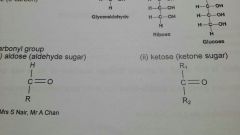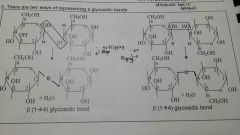![]()
![]()
![]()
Use LEFT and RIGHT arrow keys to navigate between flashcards;
Use UP and DOWN arrow keys to flip the card;
H to show hint;
A reads text to speech;
20 Cards in this Set
- Front
- Back
|
Characteristics of Monosaccharides |
1. Cannot be hydrolysed further 2. Carbonyl group (>c=o) 3. Multiple hydroxyl groups |
|
|
Classification-location of carbonyl group |

|
|
|
Classification - alpha and beta forms |
(-OH) group attached to C1 -> abv = beta (bird) -> under = alpha (fish) |
|
|
Significance of monosaccharides |
1. Small size, (CH2)n => soluble; ez transport 2. Pen/hexose can exist as rings => stable bldg blks of larger molecules 3. Rings exhibit a, b isomerism => increase diversity of m.sacc. as bldg blks 4. Free carbonyl grp (C=O) => reducing ability. |
|
|
Characteristic - di.sacc. |
- 2 m.sacc. joined by glycosidic bond ~ condensation ♢1 h2o removed - C12H22O11 |
|
|
Maltose |
- a-gl+a-gl - a (1-4) glycosidic bond |
|
|
Sucrose |
- a -Gl+b-Fr - a (1-2) glycosidic bond |
|
|
Common di.sacc. |
Gl+Gl=Malt Gl+Ga=Lact Gl+Fr=Sucrose |
|
|
Describe benedict's test |
1. Reducing sugar (m.sacc & sm di.s) - 2 cm3 solution + 2 cm3 benedict + shake -> place in boiling h2o for 3-4mins 2. Non-reducing sugar - Negative ben test + dilute hcl immersed in boiling h2o for 1 min to hydrolyse + neutralisation ( sodium bicarbonate) + reducing sugar test 🚺 = negative 🔴 = positive |
|
|
Reducing and non reducing di.sacc |
Maltose and Lactose 👌 - free carbonyl grp Sucrose ❌ no free carbonyl grp |
|
|
Draw glycosidic bonds |

|
|
|
Characteristic - p.sacc |
Condensation of many m.sacc -Glys. Bond |
|
|
Starch (storage) |
- respiratory substrate oxidised to give ATP
- amylose & amylopectin - test starch: 1cm3 iodine to sol. 💙=✅ |
|
|
Starch - amylose |
a-glucose a (1-4) glys bond helical structure |
|
|
Starch - amylopectin |
a-glucose
W/in branch = a (1-4) glys Branch pt = a (1-6) glys
Helical + helical side chains at branch pt. |
|
|
Glycogen (storage) |
More extensively branched than amylopectin -> more efficent enzyme action
W/in branch = a (1-4) glysBranch pt = a (1-6) glys Glycogen molecule coiled into helix |
|
|
Storage molecules (amylose, amylopectin, glycogen) |
1. Many glucose residues to hydrolyse into m.sacc. (like glucose to use as respiratory substrate to obtain ATP) and makes it insoluble 2. Helices - excellent packing per unit volume - intramolecular h-bond for (-OH) grps (less h bond with h2o) 3. Branching (a.pec & glyco) - allow multiple hydrolytic enzym3s to operate concurrently - optimise packing many subunits per unit volume - compact - ⬇h-bond w/ h2o |
|
|
Cellulose (Stuctural) |
1. Plants 2. B-glu via B (1-4)glyc. bond 3. Alternate B-glu rotated 180° wrt e/o -> (OH grps projecting both directn) 4. Linear, unbranched 5. Cellulose chains // to e/o held via intermolecular H-bonds btw (-OH) 6. Cross linked Cellulose chain -> microfibril Meshwork microfibril -> cell wall |
|
|
Stucture to f (x): cellulose |
Indiv. Cellulose - unbranched linear structure, (-OH) grps h-bond extensively w/ other (-OH) parallel to it - macromolecule, fewer (-OH) grps for H-Bond - Insoluble in H2O |
|
|
Mashwork of microfibrils |
- porous structure -> freely permeable - strong rigid structure: meshwork directionally distributes stress ♢f (x): enclose plant cells and protect physical damage
- rare cellulase needed to break down cellulose, hard to hydrolyse |

